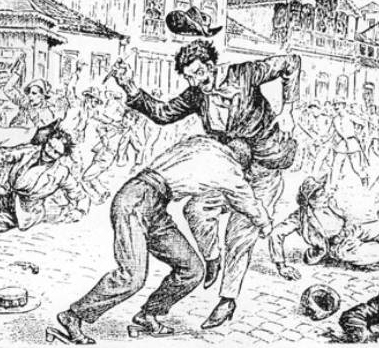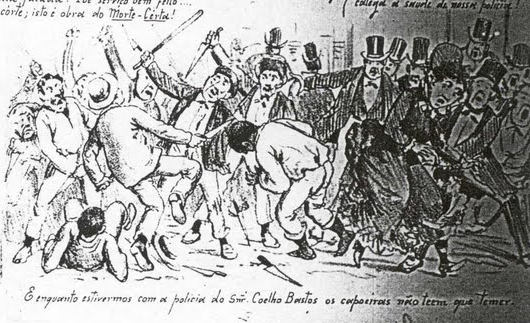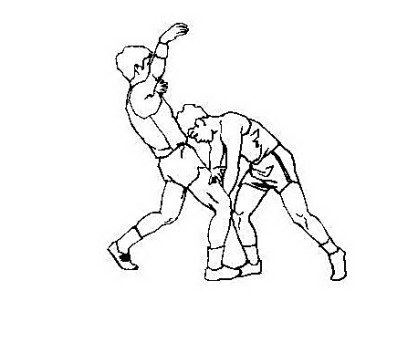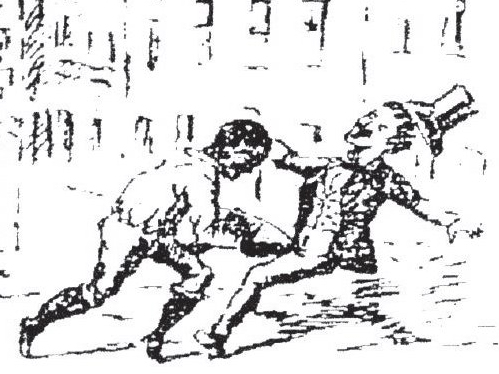

(Notice the knives; these people were not playing around).
And here, when I say 'cabecada', I meant the basic Carioca cabecada solta to the solar plexus; done using the Tiger archetype. However, similar analysis also applies to the Monkey cabecada, done while holding opponent's legs.
-
First, why there is the question at all: It is because western people are not used to seeing cabecadas at all; much less one that hits the body.
People know fist punches, kicks, and in the last years, thanks to the popularity of MMA, takedowns and ground fighting. But hitting somebody with your head to the stomach seems excessively bizzare to them; a foreign and inneffective technique.
So first, we have to say that cabecada was used in the mass street fights of capoeira gangs of Rio and Recife in the 19th century; indeed, it was one of the primary weapons.


(Notice the knives; these people were not playing around).
Second, cabecada is not just a quirk of capoeiragem. In Tiger style of kungfu, the same technique was used; taught along with other headbutts and techniques such as necklocks and backbreakers; so it was certainly not a joke technique. (For details, see my book on the Jion triad).

(This is the same technique from a Hop Gar style of Kungfu)
Having the history part down, let us look at the cabecada itself. The technique might seem vulnerable because it hits with the head, a relatively sensitive part of body. However, when we look closely, we will see it is not as bad as it looks; one is relatively protected while doing cabecada.
First, the passive defence: the crossed arms protect against knee kicks to the face; and also, to a great extent, to any attack to the torso.
(Note that unlike the shoot for double leg takedown, in cabecada, you cannot eat a knee to the head precisely for the reason you can use your hands to shield against the knee).
The head is bent down, thus the only parts that the opponent sees are the ones protected by hard bone (skull). Similarly, back is not really available for attack, as the torso is compressed by the position. The only sensitive parts that are somewhat open for attack is the face (for gouging) and the back of neck (for striking).
Second, the active defence: Cabecada is done fast; and when it hits, it shoots the opponent to the ground. That is its design; its purpose. There is a very little time during which you could do something about the head rapidly flying into your solar plexus, before you find yourself on your back on the ground. The thing your would do reflexively - lifting up your knee - does not help, as adressed above; and will only make you more vulnerable.
Third, cabecada is done when the opponent attacks; which again decreases the time he has available for any reaction or defence. (For details, see my articles on Capoeiragem tactical scheme).
-
As for the effect, when you get hit with a cabecada, you are shot to the ground on your back rather hard; perhaps even knocking the breath out of you. For a second or so, your groin is open for stomping and kicking. (Which, I would say, is something the gangsters of Rio very much liked to do after they took you down with cabecada; although it is sometimes written that they had a code of chivarly that would not allow them to attack a downed adversaly).
Again, for people who are used to knockouts by punches and kicks; or takedowns to ground grappling; this might seem strange; but throws and takedowns, even the ones that do not lead to grappling, are known and used by many grappling arts in existence.
-
Now, let us talk about the primary strong points of cabecada:
First, it is fast. Cabecada is probably the fastest takedown there is; it does not involve any grappling, does not need grips, it just comes out of nowhere and boom, the opponent is on the ground.
Second, it takes the opponent down, quickly and reliably, while you remain standing. This is especially important in multiple opponent's scenarios, such as the mass street fights cabecada was used in. That is because if you take the opponent down, there is one less person to fight with (at least it will take him some time to stand back up, which you can use to fight or escape).
Cabecada is different from a MMA takedown precisely because its purpose is /not/ to go to the ground with the opponent; in such a mass fight, grappling with one opponent might easily be lethal, as his friends can attack you from behind while your are down with him.
Third, cabecada is powerful. And here it means, it gives even a small fighter the power to take down a large adversary. And that, as is said before, it done fast. In cabecada, your whole body becomes a weapon that is hurled against the adversary; the head is just a tip of that weapon. People are not used to seeing this; but a good cabecada can easily that down an opponent that is twice your weight (we have tried that).
So paradoxically to western audience, cabecada might be an ideal weapon for smaller fighters - much better than punches or kicks.
--
Now to give you a complete picture, let us talk about the downsides of cabecada.
First, as noted, it exposes your face for gouging and back of neck for striking; if the opponent can get it.
(In fact, there are types of cabecadas that are too open, and unfit for fighting; but we do not discuss these here; see my other articles).
Second, it must be precise, hitting the opponent in the solar plexus. A failed takedown can get re-shot, but there is nothing you can do with a failed cabecada; other than quickly escape and get back your safe distance (that is why capoeira was so big on agility).
Third, it does not lead into grappling - but as we said, that we never its purpose.
Fourth, it is best used against a opponent that rushes in; it is hard to use it against an opponent that stands on guard and keeps his distance.
--
Nevertheless, as I wrote, these downsides couldn't be that big; otherwise, cabecada would not establish itself as one of the primary weapons of old Carioca capoeiras.
And if you find yourself in similar situation - being a smaller fighter against larger, multiple adversaries - it would probably work just as well today.

This Web Page was Built with PageBreeze Free HTML Editor